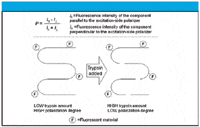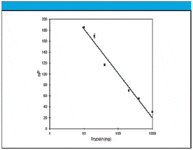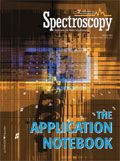Automated Fluorescence Polarization Method for Enzyme Activity Measurement
Hitachi High Technologies America, Inc.
Fluorescence polarization methods have been used in biochemical applications since the 1970's (1). Dedicated instruments that provide simple, speedy, and highly sensitive results have been used in applications ranging from the quantitative analysis of drugs in blood to PCR products (2). Here, enzyme activity of trypsin is measured using the Hitachi F-4500 fluorescence spectrophotometer equipped with the automated polarization accessory.
In the fluorescence polarization measurement system, the excitation beam is polarized and projected to the sample, and only molecules in the same orientation as the polarizer will fluoresce. The emitted fluorescence is measured in its parallel and perpendicular components separately relative to the incident polarization angle. The fluorescence polarization degree, P, is calculated by the formula in Figure 1. A smaller molecule is easier to rotate with a lower polarization degree, and a larger molecule takes a higher polarization degree.

Experimental
This experiment utilized the EnzCheck™ Polarization Assay Kit for Proteases by Molecular Probes containing a fuorescence-labeled casein (BODIPY FL-casein) and a dilution buffer (3). Pancreatic trypsin from cattle supplied by Wako Pure Chemical Industries was diluted with PBS (phosphate-buffered saline) (4). Using the conditions listed in Table I, the P value 20 min after start was measured consecutively five times with polarization degree measurements at intervals of 10–30 s. Trypsin concentrations ranged from 10–100 ng.

Figure 1. Formula for P value calculation, and a graphical representation of its relationship to enzymatic activity.
Results and Conclusions
The mean P value and standard deviation were plotted for trypsin concentrations, and a linear relationship was established as shown in Figure 2. A reduction in molecular weight with the incremental addition of trypsin was determined by measuring the decrease in P value; thus, the decrease in P value is directly proportional to the enzymatic activity of trypsin.

Table I. Experimental Conditions
Summary
The Hitachi F-4500 fluorescence spectrophotometer equipped with the automated polarization accessory accurately quantifies enzymatic activity using the fluorescence polarization method.

Figure 2. Plot of mean P value versus trypsin concentration.
References
(1) The Hitachi Scientific Instrument News 27(3), (1984).
(2) The Hitachi Scientific Instrument News 42 (1), (1999).
(3) "EnzCheck™ Polarization Assay Kit for Proteases (E-6658)," Molecular Probes (Carlsbad, California, 1999).
(4) T. Tamura, Genetic Engineering ExperimentNote 1, 168 (1997).
Hitachi High Technologies America, Inc.
3100 North First Street, San Jose, CA 95134
Tel. (800) 548-9001, Fax (408) 432-0704

New Study Reveals Insights into Phenol’s Behavior in Ice
April 16th 2025A new study published in Spectrochimica Acta Part A by Dominik Heger and colleagues at Masaryk University reveals that phenol's photophysical properties change significantly when frozen, potentially enabling its breakdown by sunlight in icy environments.
Tracking Molecular Transport in Chromatographic Particles with Single-Molecule Fluorescence Imaging
May 18th 2012An interview with Justin Cooper, winner of a 2011 FACSS Innovation Award. Part of a new podcast series presented in collaboration with the Federation of Analytical Chemistry and Spectroscopy Societies (FACSS), in connection with SciX 2012 ? the Great Scientific Exchange, the North American conference (39th Annual) of FACSS.
Thermo Fisher Scientists Highlight the Latest Advances in Process Monitoring with Raman Spectroscopy
April 1st 2025In this exclusive Spectroscopy interview, John Richmond and Tom Dearing of Thermo Fisher Scientific discuss the company’s Raman technology and the latest trends for process monitoring across various applications.
A Seamless Trace Elemental Analysis Prescription for Quality Pharmaceuticals
March 31st 2025Quality assurance and quality control (QA/QC) are essential in pharmaceutical manufacturing to ensure compliance with standards like United States Pharmacopoeia <232> and ICH Q3D, as well as FDA regulations. Reliable and user-friendly testing solutions help QA/QC labs deliver precise trace elemental analyses while meeting throughput demands and data security requirements.